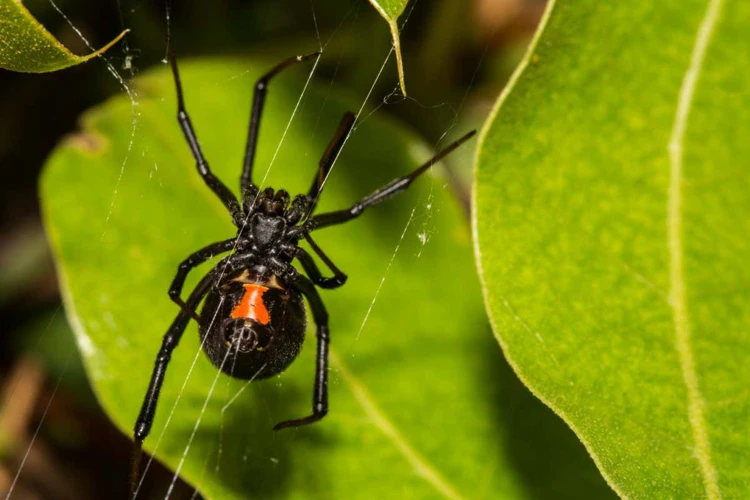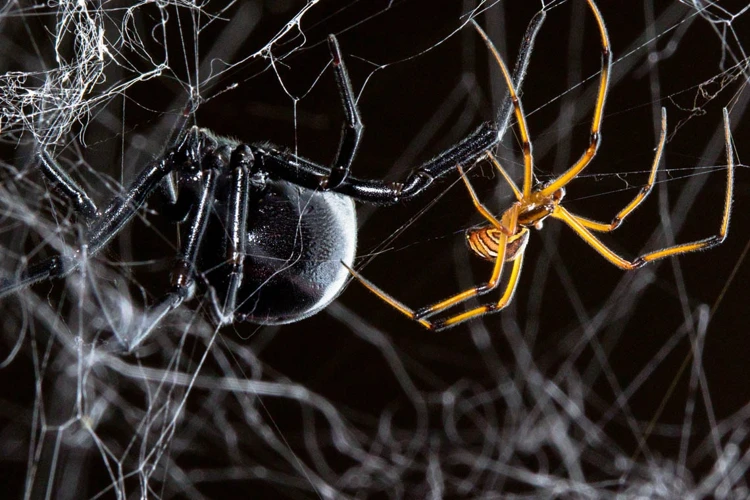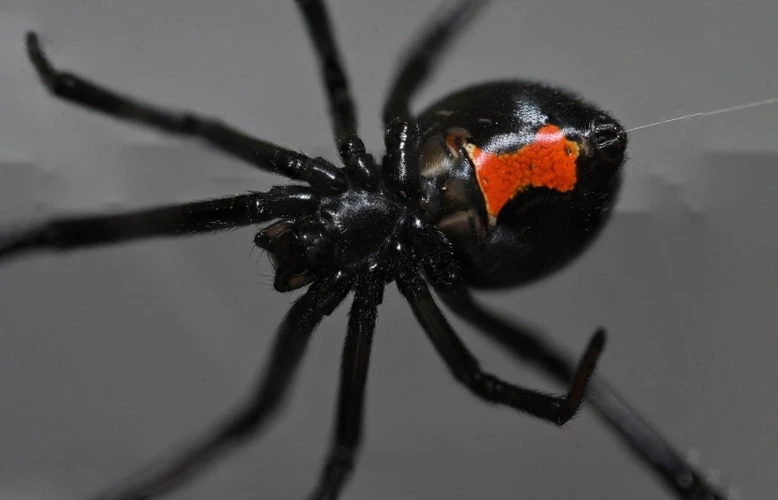The world of spiders is fascinating and often mysterious. One of the most iconic and feared spiders of all is the black widow. Found throughout the world, these venomous arachnids have a reputation for being deadly and elusive. However, there is more to their story than just danger and intrigue. Black widows have complex interactions with other species in their environment, constantly competing for resources and space. In this article, we will explore the fascinating world of black widow spider interactions with other species, examining the dynamics of predator and prey relationships, competition for habitat, and more. So buckle up, grab your magnifying glass, and let’s take a closer look at what makes black widows such fascinating creatures!
The Prey

As one of the most feared predators in the animal kingdom, black widow spiders have a unique set of prey. These eight-legged hunters are known for their venomous bite, which paralyzes their prey, making it easier for them to consume it. However, what type of prey do black widows compete for? Throughout history, the black widow spider has had to compete with other species for its survival. It’s important to understand the dynamics of their interactions with their prey and how they manage to remain at the top of the food chain. In this section, we will highlight some of the black widow spider’s prey and delve into how they compete for survival. For more on the habitat requirements for black widows, check out black widow spider habitat.
Black Widows Vs. Other Spiders
Black widows are known for their deadly venom and their skill in hunting their prey. They are also known for their fierce competition with other spiders. In fact, black widows are one of the most aggressive and dominant spider species, and they will not hesitate to take over another spider’s web or territory.
To better understand how black widows interact with other spiders, let’s compare the physical characteristics and hunting behavior of black widows to those of their competitors.
| Spider Species | Physical Characteristics | Hunting Behavior |
|---|---|---|
| Black Widows | Small to medium-sized body, shiny black color, red hourglass shape on underside | Spin webs to capture prey, lunge and bite prey with venomous fangs |
| Wolf Spiders | Large, hairy body, usually brown or gray in color | Do not spin webs, chase and pounce on prey, use venom to immobilize prey |
| Jumping Spiders | Small, compact body, usually brightly colored and patterned | Do not spin webs, stalk and ambush prey, use venom to kill prey instantly |
| Orb-Weaving Spiders | Large, colorful body, often with distinctive markings | Spin complex webs to capture prey, wait for prey to become entangled, move in for the kill |
As we can see from the table, black widows have a unique combination of physical characteristics and hunting behavior that make them well-suited for their habitat. However, they are not invincible and must still compete with other spider species for resources.
To learn more about the black widow’s habitat and how it relates to their interactions with other species, read on to the next section. If you’re interested in attracting black widows to your property or need to control their population, check out our article on attracting and controlling black widows.
Black Widows Vs. Insects
Black widows are known for their potent venom and how they use it to capture prey. However, their hunting methods are not limited to just other spiders. Insects are also part of their diet and they have their ways of dealing with them. Let’s explore how black widows compete with insects for their habitat.
- Web-building: One of the ways black widows can catch insects is through their web-building skills. They spin a tangled web that is often difficult for small insects to get through, especially if they are trapped in it.
- Viscous glue: The web is constructed with a sticky glue that is difficult for insects to escape once they are caught in it. The viscosity of the glue ensures that the insect remains trapped until the black widow comes to collect the prey.
- Prey attraction: Black widows also attract insects to their webs by secreting a pheromone that lures the prey towards them. This pheromone is unique to black widows and ensures that only their prey comes towards them.
- Ambush predation: Insects that are wary of black widow webs may still fall prey to them when they least expect it. Black widows often hide behind leaves or other debris and wait for unsuspecting insects to get caught in their webs. They then pounce on their prey and inject them with venom.
However, insects are not completely defenseless against black widows. Some larger insects like beetles or grasshoppers may be able to break through the web or simply overpower the spider. Additionally, some insects have developed behavioral adaptations to avoid being caught in web traps, such as avoiding certain types of vegetation that black widows prefer to build their webs on.
Black widows compete with insects for their habitat by using their web-building and hunting skills as well as their unique pheromones. However, insects also have their own defenses against black widows and may be able to avoid being trapped in their webs. To fully understand the competition for black widow habitats, it is important to consider both sides of the equation and ecologically evaluate the factors at play.
The Competition

As black widow spiders occupy a certain habitat, they inevitably end up competing with other species for limited resources. This is especially true when it comes to food, shelter, and reproduction. Let’s explore some of the most common competitors for black widows in their natural habitat, and examine the complex dynamics of these interactions. It’s fascinating to consider how these creatures adapt and evolve to survive and thrive in their environments. To understand the competition, we need to analyze black widows’ interactions with other spiders, predators, and prey.
Black Widows Vs. Other Spiders
Black widow spiders are notorious predators, and other spiders are no exception. The competition between black widows and other spiders is ongoing, and it is interesting to witness. Here are some ways in which black widows compete with their fellow spiders:
- Web building: Black widows build web in irregular meshes with entangled threads. This can help them catch prey quickly before other spiders get a chance.
- Aggressive behavior: Black widows exhibit aggressive behavior towards other spiders in their vicinity. They may fight with other spiders for food and other resources, even resorting to cannibalism.
- Predation: Black widows feed on other spiders, including the males of their own species, as a way of reducing competition for resources.
However, it is not just about competition for resources. For instance, many factors can make one spider species more suitable for a particular habitat than another. In this case, the black widow might not necessarily beat out other spiders. Factors such as humidity, vegetation, and moisture play a vital role in determining whether the habitat is suitable for the black widow or not. It is essential to understand these factors to create a suitability index that can help predict where the spider might thrive.
Black Widows Vs. Other Predators
When it comes to other predators in the ecosystem, black widow spiders have developed various mechanisms for self-defense. One of the most well-known is their venomous bite, which can effectively paralyze and kill many predators in a matter of minutes. However, there are still some predators that have developed immunity to black widow venom, and they pose a significant threat to these spiders.
To better understand the interactions between black widows and their predators, we can compare their different characteristics in the following table:
| Predictors | Characteristics |
|---|---|
| Praying mantis | An insect that preys on other insects. They are known for their speed and agility, as well as their ability to camouflage themselves. |
| Scorpions | Arachnids that are similar in size to black widows. Their exoskeletons serve as a natural defense against predators. They also have pincers that can be used to capture prey. |
| Birds | Various birds, including the common house sparrow, have been known to feed on black widow spiders. They use their sharp beaks to pierce the spider’s exoskeleton and inject venom into their prey. |
| Snakes | Some species of snakes, such as the king snake, are immune to black widow venom. They are able to capture and consume these spiders with ease. |
As we can see from the table above, there are various predators that black widows must be wary of. Even with their venom, they are not invincible in the ecosystem. This is why finding a suitable habitat where they can minimize their interactions with other predators is crucial to their survival.
If you want to learn more about the various abiotic factors that affect black widow habitat, check out our previous article. Additionally, you may be interested to know how light impacts these spiders – read more in our article on the impact of light on black widows.
The Habitat
As black widows spread across different regions, they face the challenge of finding a suitable habitat to call home. The environment plays a significant role in shaping their survival and interactions with other species. However, their search for a comfortable habitat isn’t an easy feat, as they encounter various competitors and obstacles along the way. Let’s dive deeper into the black widow’s habitat and the challenges that come with it.
Black Widows Vs. Other Spiders
When it comes to competing for habitat, black widows are no exception, even when it comes to their spider counterparts. Here are some other spider species that black widows may have to compete with for their homes:
- Brown Recluses: These spiders have a similar habitat to black widows, preferring warm and dark areas. Both spiders can be found hiding in sheds, garages, and woodpiles.
- Hobo Spiders: Hobo spiders also prefer dark and secluded areas like black widows, and their range overlaps that of black widows in parts of the United States.
- Wolf Spiders: While wolf spiders prefer a more open habitat, they may still come into contact with black widows in areas like gardens or outdoor sheds.
Despite the competition, black widows have some advantages over these other spiders. For example, their venom is much more potent than that of most other spider species, which gives them an edge in hunting and defending their territory. However, it’s important to note that black widows will only use their venom as a last resort, and will typically flee if given the chance.
Black Widows Vs. Humans
When it comes to black widows, humans are undoubtedly their biggest competitors for habitat. Unlike other predators, humans have the power to control and manipulate the environment to their advantage. This means that black widows may often find themselves competing with humans for space to build their webs and thrive.
Reasons Why Black Widows and Humans Compete for Habitat
– Urbanization: As cities grow, natural habitats are destroyed to make way for new housing and development, giving rise to more urban areas. More often than not, this means black widows have to share their space with humans.
– Human Activity: Humans tend to move around a lot, leaving objects like furniture, tools, and vehicles behind. These objects may become ideal habitats for black widows, especially if they are left undisturbed for long periods.
– Encounters: Humans often unintentionally come into contact with black widows and may trample or destroy their webs while going about their daily activities.
Human-Black Widow Interactions
Human-black widow interactions are typically not pleasant, due to the spider’s notorious venom. Black widow bites can be painful and even fatal, making humans understandably wary of sharing space with them. Despite this, black widows are typically shy and prefer to keep to themselves, only attacking humans in self-defense or if they feel threatened in some way.
How Humans Deal with Black Widow Infestations
When humans discover black widow infestations in their homes or places of work, they may take one of several measures to get rid of them:
– Sealing cracks and crevices: This is one of the best ways to prevent black widows from entering human spaces in the first place.
– Pesticides and insecticides: Humans may use common household pesticides and insecticides to kill black widows and their prey.
– Professional pest control: In severe cases, humans may call in professional pest control services to identify and eliminate black widow infestations.
Despite the competition between black widows and humans for habitat, it is possible for them to coexist. Humans can take measures to prevent or eliminate black widow infestations while simultaneously allowing these beneficial predators to thrive in the wild.
Conclusion
In conclusion, it is clear that black widow spiders face many challenges in the animal kingdom, especially when it comes to their habitat and competition for resources. Despite their reputation as deadly predators, black widows themselves are targeted by a variety of other species, including other spiders, insects, and even some predators.
Their unique hunting habits and venom allow them to defend themselves against some threats, but they are not invincible. The habitat of black widow spiders is also under threat from human activity and development, which can have a significant impact on their populations.
It is crucial for us to understand and appreciate the complex interactions between black widow spiders and the other species they share their environment with. By respecting and preserving their habitats, we can help ensure the continued survival of these fascinating creatures and maintain the delicate balance of ecosystems they are a part of.
In the end, it is clear that black widow spiders are a vital and essential part of our world, and their survival is intimately connected to ours. As we work to protect our environment and the incredible diversity of life within it, let us remember the important role that these spiders and other creatures play in creating a healthy and thriving world for us all.
Frequently Asked Questions
What is the venom of black widow spiders used for?
The venom of black widow spiders is used to immobilize their prey and defend themselves against predators.
What is the difference between male and female black widow spiders?
Male black widow spiders are much smaller than females, lack the red hourglass marking on their abdomen, and are not as poisonous as females.
How do black widows compete with other spider species for resources?
Black widows compete with other spider species for resources by building intricate webs to catch prey and by being more aggressive predators.
What are some common predators of black widow spiders?
Some common predators of black widow spiders include birds, lizards, and other spider species.
Are black widow spiders dangerous to humans?
Yes, black widow spiders are dangerous to humans as their venom can cause severe pain, muscle cramps, and in rare cases, death.
How do humans compete with black widow spiders for habitats?
Humans compete with black widow spiders for habitats by building structures that encroach on their natural habitats such as sheds or garages.
What is the lifespan of a black widow spider?
The lifespan of a female black widow spider can be up to three years, while male black widows typically live for only a few months.
What kind of insects do black widow spiders prey on?
Black widow spiders prey on a variety of insects such as cockroaches, crickets, and flies.
What is the range of black widow spiders?
Black widow spiders can be found throughout much of the United States, as well as in parts of Canada and Mexico.
What are some strategies for avoiding black widow spider bites?
Some strategies for avoiding black widow spider bites include wearing gloves when working outdoors, shaking out clothing and shoes before putting them on, and avoiding sticking your hand into dark crevices where black widows may be hiding.






